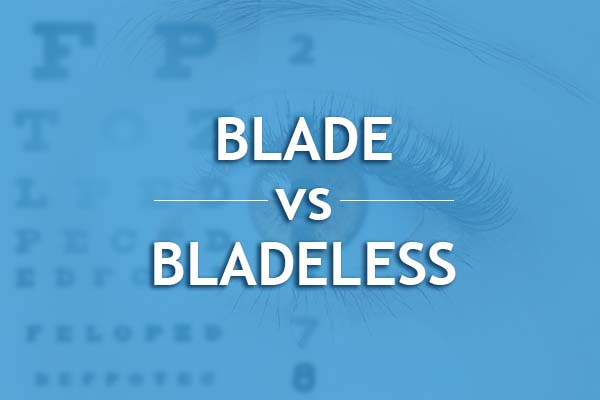
Since its introduction in 2001, LASIK vision correction has grown to become the world’s most popular elective procedure. Part of LASIK’s appeal is its safety and convenience. While complications are rare for all types of LASIK, there are some differences in risk between traditional LASIK and the more high-tech bladeless LASIK. But just what are these two procedures?
Blade vs Bladeless LASIK
In traditional LASIK, a surgeon uses a microkeratome blade—a small specially designed ophthalmic device—to cut a flap into the cornea, the clear part at the very front of the eye. The flap is then lifted to allow lasers to reshape the cornea, correcting the patient’s vision. This may sound frightening, but discomfort during the surgery is minimal. Many people wonder how LASIK feels, but many people report the procedure as painless. Plus, the microkeratome’s extreme sharpness helps the corneal flap to fit perfectly back in place for the eye to heal.
Bladeless LASIK might be a newer technique, but it’s still one that has been around for over 15 years. Also called “all-laser LASIK,” this procedure uses an IntraLASIK femtosecond laser to create the corneal flap instead of a microkeratome. Many surgeons prefer this method, as it grants more flexibility to plan and carry out a personally customized procedure for the patient. However, bladeless LASIK takes a little longer to perform and is also more expensive than traditional LASIK. Keep in mind that no matter what you choose, we’ll work closely with you so that you can afford to get the LASIK eye surgery you need.
Which Type of LASIK is Safer?
The truth is both methods are among the safest medical procedures out there. The term “bladeless” may make traditional microkeratome LASIK sound scarier, but both procedures cut directly into the cornea. However, there are some things that bladeless LASIK does better than traditional LASIK (and vice versa).
Pros and Cons of the Traditional “Blade” Procedure
Traditional LASIK is usually quicker and less time is needed for suctioning. This often translates to greater comfort and may also be safer for glaucoma patients who can experience an increase in intraocular pressure during the procedure. However, buttonhole flaps are more frequent in traditional LASIK. This complication is very rare and usually correctable by a second LASIK procedure after a few months of healing.
Related: Must Read: The Essential Guide for LASIK Post Operative Care
Pros and Cons of the Bladeless LASIK Procedure
Microkeratomes produce corneal flaps that are thinner at the center. In contrast, laser flaps are more predictable and have consistent thickness throughout. These higher-quality flaps mean an even lower less risk of complications, including a decreased risk of corneal abrasions and astigmatism. Consistency also means that all-laser LASIK is an especially good option for patients with more curved or thinner corneas.
Among bladeless LASIK complications, there is only one unique symptom that doesn’t typically happen with traditional LASIK: transient light sensitivity. Around 1% of patients who undergo bladeless LASIK experience this syndrome a few weeks after surgery. The problem usually goes away after treatment with medicated prescription eye drops.
Which Should You Choose?
If you’ve had previous corneal surgery, microkeratome LASIK might be necessary. With all-laser procedures, water bubbles form and may get through previous incisions, interfering with the focusing (reshaping) laser.
Otherwise, the choice between all-laser and bladeless LASIK usually comes down to patient preference and their ophthalmologist’s judgment. At LASIK of Nevada, our doctors have years of experience in performing both traditional and bladeless LASIK. If you’re considering LASIK, we’ll work with you to figure out which one is right for your eyes. Call us at 1-888-498-2020 for a free consultation.
